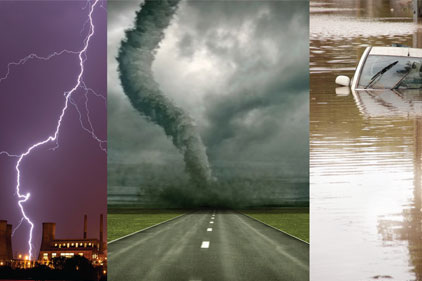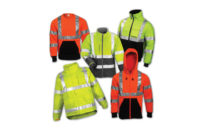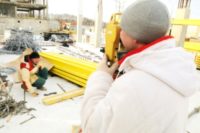Remember that famous Christmas song “Let It Snow,” written by lyricist Sammy Cahn and composer Jule Styne way back in 1945? It is a reminder that frightful weather has been with us forever. But weather events of the past year or so have put an exclamation point on that fact:
A heat wave roasted the central and eastern United States this summer with unseasonably high heat and humidity.
The U.S. heartland has been battered by the worst tornado outbreak in decades. Nearly 1,000 twisters have touched ground in the past 12 months, killing more than 500 people and racking up $9 billion in damages.
Fast-moving, unpredictable storms give businesses and citizens scant time to prepare. In the deadly twister that devastated Joplin, Mo., the tornado warning system gave residents 24 minutes to hunker down or get out of town. More than 7,000 homes were destroyed in the city of 50,000. The May 22 tornado killed 159 people, displaced 5,000 workers, smashed 10 public school buildings and ruined 18,000 cars. The funnel left a trail of damage nearly 14 miles after touching down.
The Mississippi River flooded thousands of square miles this spring. The Midwest experienced its wettest month of April in 116 years.
April was the driest month in a century in Texas. June was the warmest in Texas on record.
A major drought has enveloped 14 states.
Parts of Texas and Oklahoma exceeded in the summer of 2011 yearly average number of days at or above 100 degrees.
A haboob, a massive dust cloud about 100 miles wide, rolled through Phoenix earlier this year, knocking out power, grounding flights, and reducing visibility to near zero.
There has been an increased number of Category Four and Category Five hurricanes.
What, me worry?
It could be businesses are suffering from “disaster fatigue.” So much bad news about the weather we’ve become inured to it.
Consider the findings of a 2010 survey of businesses nationwide conducted by AT&T:
● One-fourth (23 percent) of all executives surveyed say business continuity planning is “not a priority.”
● Still, eight out of ten (83 percent) executives indicate their company does have a business continuity plan.
● One in ten do not have any such plan. And five percent can’t tell you whether they have a plan or not.
● A little more than half (54 percent) of companies have had their continuity plans fully tested in the past year. How about your company?
● That still leaves almost one in two businesses vulnerable; with emergency plans that have not been practiced.
● No shocker here: Executives of firms along the Gulf Coast are most likely to say their emergency plans have been tested in the past year — 61 percent. Given the susceptibility to and recent experiences in this area with hurricanes, it is not surprising that business continuity plans are tested annually.
● This is symptomatic of safety attitudes in general among many employers: you have to get “burned” by a serious injury event or fatality to become a believer in preparedness.
● Nationally, six out of ten companies (62 percent) implement specific proactive actions when the federal or state government issues an alert for an impending disaster.
● Again, Gulf Coast companies are out in front here, with 72 percent most likely to “take action.” Once burned, twice as alert.
● What of the nearly 40 percent of companies that apparently have more nonchalant attitudes about disaster warnings? Maybe their facilities have never been hammered. Maybe they are small businesses, retail operations, or offices without hazardous substances on site. But do they have a plan for getting their employees home safely before wicked weather arrives? And a method for accounting for employees and making sure they did arrive home safely?
Stock your inventory
If your business processes, stores and/or transports dangerous chemicals, and suddenly you are alerted to a twister coming your way, or a hurricane or thunderstorm with gale-force winds, what happens if those dangerous chemicals go flying, spill, or are otherwise released? Make sure you maintain an emergency stockpile of:
- Hazardous materials cleanup kits and equipment
- Decontamination equipment
- Chemical protective suits for cleanup and recovery
- Facility warning systems, alarms, signs
- Spill absorbents
- PPE gloves, boots, respirators, hard hats, clothing used by cleanup workers. Think of the photos of Hurricane Katrina cleanup workers in respirators, gloves, boot, yellow suits, etc.
- Emergency respiratory escape hoods
- Emergency showers and eyewashes for employees splashed with spilled chemicals
- Fire extinguishers
- Storage containers for hazardous substances
- Material Safety Data Sheets to inform cleanup and recovery workers of the hazards of chemicals they are exposed to.
Small business nonchalance
In a 2009 survey, 90 percent of small companies (those with fewer than 100 employees) reported they spend less than one day a month on business continuity. This is obviously taking a walk on the risky side. Here’s what the Small Business Administration has to say:
“An unforeseen disaster closes your business. The clock is ticking, but you may not realize how urgently: Unless you reopen within five days, chances are you never will,” according to the U.S. Small Business Administration (SBA). Ninety percent of businesses that don’t reopen within that time frame fail.
Billion-dollar weather disasters
The U.S. has had five weather disasters costing more than a billion dollars this year.
We’ve already surpassed the total for billion-dollar weather disasters for all of 2010 (three), and with hurricane season still to come, this year has a chance of beating 2008’s record of nine such disasters. The billion dollar weather disasters of 2011 so far:
1. 2011 Groundhog Day’s blizzard ($1 - $4 billion)
2. April 3 - 5 Southeast U.S. severe weather outbreak ($2 billion)
3. April 8 - 11 severe weather outbreak ($2.25 billion)
4. April 25 - 28 super tornado outbreak ($3.7 - $5.5 billion)
5. Mississippi River flood of 2011 ($2+ billion)
Losses from the ongoing Texas drought and wildfires are already at $180 million, and this is likely to be a billion-dollar disaster by the time all the agricultural losses are tallied.
What OSHA requires
If you already haven’t, go to www.osha.gov and download the 2004 publication, “Principle Emergency Response and Preparedness Requirements and Guidelines.” It provides an excellent overview of agency requirements.
For general industry, these regulations include:
- Design and construction for exit routes
- Maintenance of exit routes
- Medical services and first aid
- Portable fire extinguishers
- Emergency action plans
- Fire prevention plans
- Storage and handling of anhydrous ammonia
- Process safety management (PSM) of highly hazardous chemicals
For construction, requirements for emergency response and preparedness include:
- First aid and medical attention
- Fire protection and prevention
- Means of egress
- Employee emergency action plans
Also, in 1989, OSHA issued a final rule on Hazardous Waste Operations and Emergency Response (HAZWOPER) to work hand-in-hand with the EPA’s Superfund Amendments and Reauthorization Act (SARA) of 1986. This legislation included the Emergency Planning and Community Right-to-Know act (Title III).
Disaster-induced distress
Another worthwhile topic to discuss at a safety meeting is the emotional toll that can come from workers weathering a natural disaster — or who witness a serious injury or fatality.
According to the American Red Cross, emotional reactions can include:
- Feeling physically and mentally drained.
- Having difficulty making decisions or staying focused on topics.
- Becoming easily frustrated on a frequent basis.
- Arguing more with coworkers, supervisors, family and friends.
- Feeling tired, sad, numb, lonely or worried.
- Experiencing changes in appetite or sleep patterns.
Most of these reactions are temporary. The Red Cross advises: “Try to accept whatever reactions you may have.”
The American Red Cross advises if someone is experiencing the feelings and reactions listed below for more than two weeks or longer, it can be a sign that professional assistance is warranted:
- Crying spells or bursts of anger
- Difficulty eating
- Difficulty sleeping
- Losing interest in things
- Increased physical symptoms such as headaches or stomach aches
- Fatigue
- Feeling guilty, helpless or hopeless
- Avoiding family and friends
Wreaking havoc on your health
Here is a good topic for one of your safety and health meetings with employees: how weather can affect how one feels. Several examples, courtesy of WebMD:
Migraine headaches and weather changes: Falling barometric pressure, a sharp increase in humidity, a sudden drop in temperature — these weather changes may trigger migraines in people already susceptible to them. Research supports the theory that changing weather triggers migraines. In one survey that asked migraine sufferers to list triggers, 53 percent responded “weather.”
Migraine sufferers can take some action against weather-induced headaches. First, keep a diary of their migraines to make cause-and-effect connections. Then, if weather changes seem to play a role in migraines, the next step may be to discuss pretreatment with a doctor to avoid the onset of pain.
Chilly, damp weather stiffens joints: In studying the relationship of weather to arthritic pain in weight-bearing joints, preliminary data show a significant correlation between joint pain and changes in weather.
Instead of simply reacting to weather-associated increases in joint pain with measures like placing heating pads over painful joints and doubling up on analgesics, use proactive measures to improve joint function, such as engaging in nonweight-bearing exercises.
Extreme temperatures increase heart risk: The greatest exertion-related risk to patients with heart disease isn’t bungee jumping or deep-sea diving — it is shoveling snow. Already, people who suffer from heart disease can have narrowed coronary arteries. Add to these factors the additional exertion required for shoveling snow, and the scenario can quickly turn into a dangerous, even deadly, heart attack.
Helping your recovery
The Red Cross advises taking these actions to help get your life back in order:
Eat healthy: During times of distress, it is important that you maintain a balanced diet and drink plenty of water
Get some rest: With so much do, cleanup, etc., it might be difficult to have enough time to rest or get adequate sleep. Giving your body and mind a break can boost your ability to cope with distress.
Be patient: Recognize that you and your coworkers, supervisors, managers, family and friends are
distressed after a disaster and may need time to put your feelings and thoughts in order.
Stay upbeat: Remind yourself you’ve succeeded in getting through hard times in the past. Don’t hold back: reach out for support when you need it. And be there for coworkers, family and friends when they need it.
NFPA 1600® Standard on Disaster/Emergency Management and Business Continuity Programs – 2010 Edition
This edition of NFPA 1600 was approved as an American National Standard on December 5, 2009.
Though strictly voluntary, the standard is a valuable resource for any business serious about protecting people and property in the event of natural or man-made disasters.
The standard provides foundational criteria to develop, implement, assess and maintain programs for prevention, mitigation, preparedness, response, continuity and recovery.
- As with any safety and health program, the leadership team of an organization must “buy into” a full commitment to follow the standard’s requirements.
- A program coordinator and program committee should be appointed.
- The planning process should identify lines of authority; lines of succession for the organization; interfaces with external organizations, such as the fire service and emergency medical services; the process for delegation of authority; and the health and safety needs of personnel, among other planning activities.
- A risk assessment should be conducted to identify natural hazards (geological, meteorological, and biological); human-caused events (accidental and intentional); and technology-caused events (accidental and intentional).
- The impact of these hazards on the health and safety of persons in affected areas should be assessed for vulnerabilities.
- Prevention and mitigation strategies should be devised and implemented.
- Resource needs must be identified and provided for.
- The need for mutual aid/assistance must be determined.
- Communication and warning systems should be identified. They should be reliable and redundant. Protocols and procedures should be developed and tested.
- Emergency response plans should be developed with specific responsibilities and designated individuals identified.
- A strategy should be developed and implemented for communicating with employees. The strategy should include emergency contact information outside the anticipated hazard area; an accounting for persons affected, displaced or injured; temporary, short-term and long-term housing and feeding of displaced persons; addressing the mental health and physical well-being of persons affected by the disaster.
NFPA 1600 can be purchased from the National Fire Protection Association at www.nfpa.org. Also, an on-site seminar on disaster/emergency management and business continuity can be taught at your location. Call (877) 336-3280 or email onsiteseminars@nfpa.org.
Home hazards
Here’s how to prepare and best lock-down your home in the face of an impending weather crisis. The American Red Cross advises:
- Repair defective electrical wiring and leaky gas connections.
- Fasten shelves securely and brace overhead light fixtures.
- Place large, heavy objects on lower shelves.
- Hang pictures and mirrors away from beds.
- Strap water heater to wall studs.
- Repair cracks in ceilings or foundations.
- Store weed killers, pesticides and flammable products away from heat sources.
- Place oily polishing rags or waste in covered metal cans.
- Clean and repair chimneys, flue pipes, vent connectors and gas vents.



